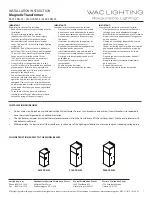
11 TN5FCXA2VG-E
3.1 Installation
During the unpacking of the transmitter, check the conformity of the transmitter and all the ac-
cessories.
Before installation, the customer must check the compatibility of the wetted parts for the ap-
plication. The possibility of a modification of the process has to be taken in account by the
customer.
The transmitter can be installed on a 2” tube or wall mounted.
The level transmitter FKE has a remote seal and can be installed directly on a counter flange.
Note :
For the wall mounting, the customer has to supply the M8 bolting.
Please refer to the data sheets for the outline dimension drawings of the transmitters.
An explosion proof certified transmitter has to be used on a process with
explosive gas otherwise there will be a risk of accident (explosion, fire etc)
DANGER
If the transmitter is not used soon after delivery, then leave it packed and store it in
a room at the normal temperature and humidity (25°C <77°F>, 60% RH).
INDICATION
Transmitter
Bracket
Plain washer
Spring washer
Mounting bolt
(M8 12)
Process flange
Bracket
Plain washer
Spring washer
Mounting bolt
(M8x12)
Transmitter
FKC, FKG and FKA models
FKD, FKB and FKM models
Mount the bracket on the transmitter as shown below.
Bracket mounting
- The transmitter is heavy. Be careful when handling it.
- The indicated installation and the wiring conditions of the transmitter must
be strictly followed.
- A wrong manipulation can be the reason of a disfunction of the transmitter.
- During installation, make sure that no part which could be the reason of the
disfunction or a danger is located inside the electronics housing.
- When the transmitter is installed in a flame proof area :
The local indicator position must not be changed
The position of the electronics housing must not be changed
- The isolating valves and manifold must correspond to the maximum pres-
sure in the pipe. If the valves and the connections do not correspond to the
max pipe pressure, there will be a risk of gas leakage or dangerous fluid.
- The pipes need to be according the process temperature and the pressure
standards.
- Diaphragms are very sensitive. Be careful during the manipulation.
- Do not bend excessiviely the capillary
DANGER















































